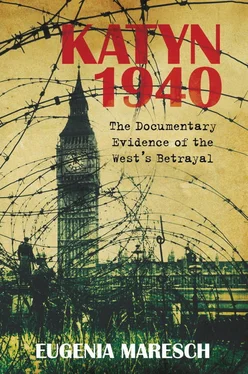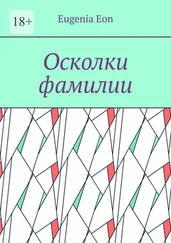5. Our information about these events is derived for the most part from those routed to Griazovets, all of whom were released in 1941 and some of whom – notably M. Komarnicki, the Polish Minister for Justice, are now in England.
6. Entrainment of the 10,000 officers from the three camps went on all through April and the first half of May, and the lorries, lined with cheerful faces, which took them from camp to station, were in fact the last that was ever seen of them alive by any witness to whom we have access. Until the revelations made by the Germans broadcast of April 12th 1943, and apart from a few words let drop at the time by the prison guards, only the testimony of scribbling on the railway wagons in which they were transported affords any indication of their destination. The same wagons seem to have done a shuttle service between Kozelsk and the detraining station; and on these some of the first parties to be transported had scratched the words: ‘Don’t believe that we are going home’, and the news that their destination had turned out to be a small station near Smolensk. These messages were noticed when the vans returned to Smolensk station, and had been reported to us by prisoners at Kozelsk, who were later sent to Griazovets.
7. But though of positive indications as to what subsequently happened to the 10,000 officers there was none until the grave at Katyn was opened, there is now available a good deal of negative evidence, the cumulative effect of which is to throw serious doubt on Russian disclaimers of responsibility for the massacre. (See also my despatch No.52 Secret of today’s date).
8. In the first place, there is the evidence to be derived from the prisoner’s correspondence in respect to which information has been furnished by officers’ families in Poland, by the officers now with the Polish army in the Middle East, and by the Polish Red Cross Society. Up till the end of March 1940, large numbers of letters had been despatched, which were later received by their relatives, from the officers confined at Kozelsk, Starobelsk and Ostashkov; whereas no letters from any of them (excepting from the 400 moved to Griazovets) have been received by anybody, which had been despatched subsequent to that date. The Germans overran Smolensk in July 1941, and there is no easy answer to the question why, if any of the 10,000 had been alive between the end of May 1940 and July 1941, none of them ever succeeded in getting any word through to their families.
9. In the second place there is the evidence of the correspondence between the Soviet Government and the Polish Government. The first request for information about the missing 10,000 was made by Minister Kot to Wyshinsky [Andrei Vyshinsky] [11] Andrey Vyshinsky (1883–1954) politician, lawyer, from 1935–39 Procurator General of the USSR, from 1949–53 Minister of Foreign Affairs and a Delegate to the United Nations Organisation.
Deputy Foreign Minister on October 6th, 1941. On December 3rd, 1941, General Sikorski backed up his enquiry with a list of 3,845 names of officers included among them. General Anders furnished the Soviet Government with a further list of 800 names on March 8th 1942. Enquiries about the fate of the 10,000 were made again and again to the Russian Government verbally and in writing by General Sikorski, M. Kot, M. [Tadeusz] Romer [Ambassadors to Russia 1942–43], Count Raczyński [Foreign Affairs] and General Anders, between October 1941 and April 1943. The Polish Red Cross between August and October 1940 sent no less than 500 questionnaires about individual officers to the Russian Government. To none of all these enquiries extending over a period of two-and-a-half years was a single positive answer of any kind ever returned. The enquirers were told either that the officers had been released, or that ‘perhaps they are already in Germany’, or that ‘no information’ of their whereabouts was available, or (M. Molotov to M. Kot, October 1941) that complete lists of the prisoners were available and that they would all be delivered to the Polish authorities ‘dead or alive’. But it is incredible that if any of the 10,000 were released, not one of them has ever appeared again anywhere, and it is almost equally incredible, if they were not released, that not one of them should have escaped subsequent to May 1940 and reported himself to the Polish authorities in Russia or Persia. That the Russian authorities should have said of any Polish officer in Soviet jurisdiction that they had ‘no information’ also provokes incredulity; for it is notorious that the NKVD collect and record the movements of individuals with the most meticulous care.
10. In the third place there is evidence of those who have visited the grave: first, a Polish commission including among others, doctors, journalists and members of the Polish Assistance Committee, a former president of the Polish Academy of Literature and a representative of the Mayor of Warsaw; secondly, another Polish commission which included priests, doctors and representatives of the Polish Red Cross Society; thirdly, an international commission of criminologists and pathologists of which the personnel is given in Annex II. The Report of this Commission forms Annex III to this despatch, and the reports of the two Polish commissions add little to it. Several hundred identifications have been established. All this evidence would normally be highly suspect since inspections took place under German auspices and the results reached us through German broadcasts. (For reasons reported separately in my secret despatch 52 of today’s date) There are fair grounds for presuming that the German broadcasts accurately represented the findings of the Commissions, that the Commissions’ findings were at any rate in some respects well founded, and that the grounds were sound on which at any rate some of the identifications were made.
11. In the fourth place there is the fact that a mass execution of officer prisoners would be inconsistent with what we know of the German army. The German army has committed innumerable brutalities, but the murder by them of prisoners of war, even of Poles, is rare. Had the German authorities ever had these 10,000 Polish officers in their hands we can be sure that they would have placed some or all of them in the camps in Germany already allotted to Polish prisoners, while the 6,000 other ranks, policemen and civil officials would have been put to forced labour. In such a case the Polish authorities would in the course of two years certainly have got in touch with some of the prisoners; but in fact none of the men from Kozelsk, Starobelsk or Ostashkov have ever been heard of from Germany.
12. Finally there is the evidence to be derived from the confusion, which characterises explanations elicited from or volunteered by the Soviet Government. Between August 1941 and April 12th, 1943, when the Germans announced the discovery of the grave at Katyn the Russian Government had, among other excuses, maintained that all Polish officers taken prisoner in 1939 had been released. On the other hand, in conversation with the Polish Ambassador, a Russian official who had drunk more than was good for him, once referred to the disposal of these officers as ‘a tragic error’. On April 16th, immediately after the German announcement, the Soviet Information Bureau in Moscow suggested that the Germans were misrepresenting as victims of Russian barbarity skeletons dug up by archaeologists at Gniezdowo [Gnezdovo], which lies next door to Katyn. On April 26th, M. Molotov in a note to the Polish Ambassador in Moscow said that the bodies at Katyn were those of Poles who had at one time been prisoners of the Russians but had subsequently been captured by the Germans in their advance at Smolensk in July 1941 and had been murdered then by them. On a later occasion, and when the German broadcasts gave reason to think that some bodies were sufficiently well preserved to be identifiable, the Russian Government put forward a statement that the Polish officers had been captured by the Germans in July 1941, had been employed upon construction work, and had only been murdered shortly before the German ‘discovery’ was announced. This confusion cannot easily be understood except on the assumption that the Russian Government had something to hide.
Читать дальше












